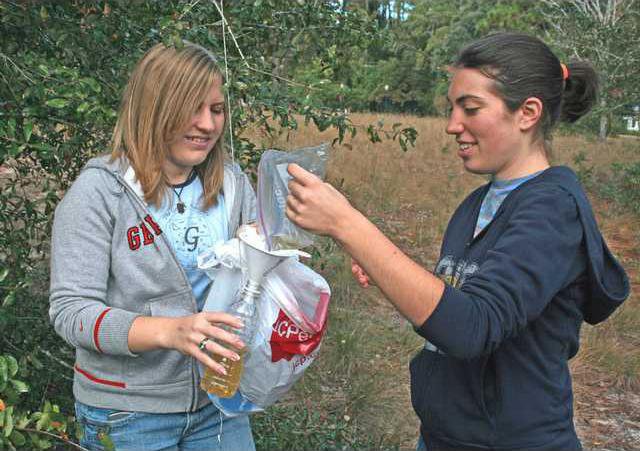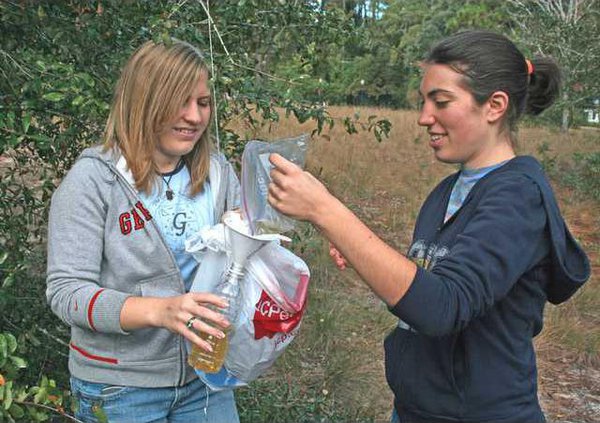The U.S. Geological Survey will issue a report on the study once the data from all the participants is collected and analyzed. To see Harvey’s field notes and photos of the project, go to http://www.bio.georgiasouthern.edu/bio-home/harvey/classes/rm_fldnotes.html
Southerners have a reputation for having a sweet tooth. Apparently, so do the wasps in this part of the country, and that is helping a group of biology honors students at Georgia Southern University learn more about them.
Eleven students in the “Research Methods in Biology” course are participating this semester in an international research project to monitor the behavior and diversity of yellow jackets and hornets.
Alan Harvey, associate biology professor at Georgia Southern, is working with the U.S. Geological Survey in the pilot project that involves universities in the United States, Canada, Great Britain and the Czech Republic.
“Through this collaboration, we can simultaneously monitor wasp populations over half the planet by coming up with sampling instructions that anyone can follow,” Harvey said.
For much of the year in South Georgia, yellow jackets and hornets are protein hunters that “keep us from being overrun by pest caterpillars,” Harvey said.
However, around the start of autumn, the animals boom in population and develop a taste for sweets instead of caterpillars, changing them from pest-controllers to just plain pests.
“If we can come up with a good way to monitor them, we might be able to better identify problem areas and eliminate only the most troublesome nests,” Harvey said.
For Georgia Southern’s study, students placed 36 traps around campus and another 36 traps at George L. Smith State Park in nearby Twin City. At both sites, traps were placed in three different habitats – a woodland, a sand hill and a recent controlled-burned area.
The traps are half-liter bottles, each containing one of three baits the class tested - apple juice, apple cider vinegar and beer. The Southern species “really like apple juice, they’re not interested in vinegar, and beer is somewhere in-between. That’s different from other parts of the world,” Harvey said.
Harvey and the students are visiting the traps once a week to check on their progress. The traps have captured more than 1,300 yellow jackets, which were identified and preserved for further study.
“This project is the perfect way to introduce the research methods I want my students to learn, and their findings could wind up being used around the world,” Harvey said. “They’re making a real contribution.”
"Being involved in the project has given me my first real taste of field work,” said Jessica Cain, a sophomore from Kennesaw, Ga.
“Going through the entire process, from brainstorming how to set up the experiment to actually collecting the yellow jackets to analyzing the data, has been a great experience. As a result, I am now more motivated to get involved in the undergraduate research opportunities at Georgia Southern."
One possible finding, according to Harvey, is that wasps may do the opposite of what many other animals do - they may not feed where their nest is. The traps close to nests collected far fewer wasps than did the traps farther from nests.
“For example, if you’re getting pestered by yellow jackets at the Russell Union, it may not do any good to eliminate the closest nest.
Their nest may be 100 yards away,” Harvey said.
Eleven students in the “Research Methods in Biology” course are participating this semester in an international research project to monitor the behavior and diversity of yellow jackets and hornets.
Alan Harvey, associate biology professor at Georgia Southern, is working with the U.S. Geological Survey in the pilot project that involves universities in the United States, Canada, Great Britain and the Czech Republic.
“Through this collaboration, we can simultaneously monitor wasp populations over half the planet by coming up with sampling instructions that anyone can follow,” Harvey said.
For much of the year in South Georgia, yellow jackets and hornets are protein hunters that “keep us from being overrun by pest caterpillars,” Harvey said.
However, around the start of autumn, the animals boom in population and develop a taste for sweets instead of caterpillars, changing them from pest-controllers to just plain pests.
“If we can come up with a good way to monitor them, we might be able to better identify problem areas and eliminate only the most troublesome nests,” Harvey said.
For Georgia Southern’s study, students placed 36 traps around campus and another 36 traps at George L. Smith State Park in nearby Twin City. At both sites, traps were placed in three different habitats – a woodland, a sand hill and a recent controlled-burned area.
The traps are half-liter bottles, each containing one of three baits the class tested - apple juice, apple cider vinegar and beer. The Southern species “really like apple juice, they’re not interested in vinegar, and beer is somewhere in-between. That’s different from other parts of the world,” Harvey said.
Harvey and the students are visiting the traps once a week to check on their progress. The traps have captured more than 1,300 yellow jackets, which were identified and preserved for further study.
“This project is the perfect way to introduce the research methods I want my students to learn, and their findings could wind up being used around the world,” Harvey said. “They’re making a real contribution.”
"Being involved in the project has given me my first real taste of field work,” said Jessica Cain, a sophomore from Kennesaw, Ga.
“Going through the entire process, from brainstorming how to set up the experiment to actually collecting the yellow jackets to analyzing the data, has been a great experience. As a result, I am now more motivated to get involved in the undergraduate research opportunities at Georgia Southern."
One possible finding, according to Harvey, is that wasps may do the opposite of what many other animals do - they may not feed where their nest is. The traps close to nests collected far fewer wasps than did the traps farther from nests.
“For example, if you’re getting pestered by yellow jackets at the Russell Union, it may not do any good to eliminate the closest nest.
Their nest may be 100 yards away,” Harvey said.

